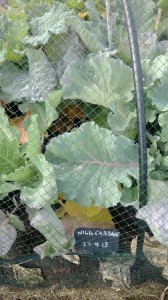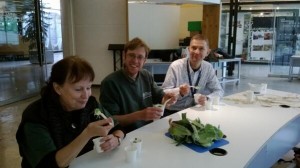By domesticating wild plants to create our familiar crops we have selected desirable traits like disease resistance, yield and flavour. The Really Wild Veg project has been examining how significant these changes have been by growing trial plots of three familiar crop plants alongside their wild relatives. The project has focussed on three crop species – cabbage, beet and radish – as all three are native Scottish coastal plants. For more information about the species and varieties grown in the trial and the participating community gardens see the 11th June blog update.
The Crop Wild Relatives are important because they hold genes that may be valuable in breeding new improved varieties. One area where the wild plants may show particular promise is in their nutritional qualities. A varied group of chemicals found in plants that are particularly important for human health are called bioactive phytochemicals. This group includes antioxidants and anthocyanins among many others and can help prevent cancer, heart disease and diabetes. In order to investigate this interesting area further the Really Wild Veg project has teamed up with the Rowett Institute of Nutrition and Health. The Rowett’s lab in Aberdeen will analyse the samples supplied from across all five gardens that have participated in the trials. This will provide a picture of how the phytochemicals have changed their makeup and concentration as a result of domestication.
Nutritional analysis was only one part of the project and all the participating gardens also measured productivity by weighing the above ground parts of their crop. Disease and pest issues were also noted and quantified where possible. Finally, the growers had fun trying to assess flavour variation among the three representatives – wild, heritage variety and modern variety – of each crop species. Taste is a subjective thing and the appearance of food can influence our experience of taste so the taste trials have been more about engaging the public than conducting scientifically rigourous research. Nevertheless, the results on taste , productivity and disease have proved to be interesting. A summary of the result from the Edible Gardening Plots in Edinburgh is provided below:
Taste – 211 people were asked in a blind tasting of shredded cabbage that had been dressed with a light rapeseed oil and vinegar dressing to select their favourite from the three samples.
- 51% selected wild cabbage
- 28% selected the heritage variety of cabbage
- 21% selected the modern F1 variety of cabbage
The comments recorded how people noticed a stronger flavour in wild cabbage, but clearly for many people the stronger flavour was appealing.
Taste tests for radish and beet were more informal and mostly just involved the growers. In all three crop species the wild plants had the strongest flavour. For radish the wild sea radish was felt to have the best flavour but the texture was unappealing due to hairs on the leaves. For beet the heritage variety was felt to have the best flavour and the wild sea beet the worst as it was too bitter for many people.
Productivity – The above ground weight was calculated for a known number of plants as a way of providing a fair comparison between wild, heritage and modern F1 crops.
- Radish – ‘Red stemmed’ F1 best at 2,000g, ‘Sai Sai’ heritage variety 1,850g, and wild sea beet worst at 900g (all based on 10 plants)
- Beet – Wild sea beet best at 1,925g, ‘Swiss chard’ heritage variety 1,900g, and ‘Fantasy’ F1 worst at 1,500g (all based on 10 plants)
- Cabbage – ‘Kilaxy’ F1 best at 10,580g, ‘Early Winningstadt’ heritage variety 7,775g, and wild cabbage worst at 4,235g (all based on 7 plants)
Disease – Disease and pests were noted and quantified where possible.
- Radish – No varieties or wild species displayed any recordable pests or diseases
- Beet – No varieties or wild species displayed any recordable pests or diseases
- Cabbage – Wild cabbage suffered fewest problems with little pest damage and only one case of mildew, ‘Kilaxy’ F1 suffered limited pest damage and 50% mildew infestation, ‘Early Winningstadt’ heritage variety suffered most problems with all plants suffering from pest damage and mildew infestation
What the results show is that the modern day F1 varieties do score well on productivity and disease resistance, although not best in every case. The F1 plants are also very uniform. The wild plants and heritage varieties show greater variability but in some cases beat the F1 varieties on productivity and disease. What is perhaps a surprise is how poorly the F1 varieties perform in terms of flavour. Wild plants take the top spot on flavour in two out of three taste tests. F1 varieties came bottom in two out of three taste tests and only managed second place in the beet taste test.
It is probably not wise to draw too much from this small sample, but what the results suggest is that wild plants have stronger flavours than domesticated plants and that the breeders of modern crop varieties have paid less attention to flavour than other desirable traits (at least in this case).
The results on nutritional analysis are eagerly awaited! Watch this space.



Alison Tindale
Did you ever get the nutritional analysis results?
Max Coleman
Dear Alison,
The nutritional analysis is a really exciting part of this project and we are awaiting results from the Rowett Institute of Nutrition and Health. I was told recently that the first results should be available in May. As there is a plan to publish the results there could be a bit of a delay before we can release them online. Thanks for your interest and sorry that this has taken a while. I’m sure it will be worth the wait. We do intend running this project again in 2014 so keep an eye on the blog for updates.
Regards,
Max
Alison Tindale
Thanks Max, I’ve been following the story on my blog about perennial vegetables. Glad I didn’t miss them and yes will watch this space!